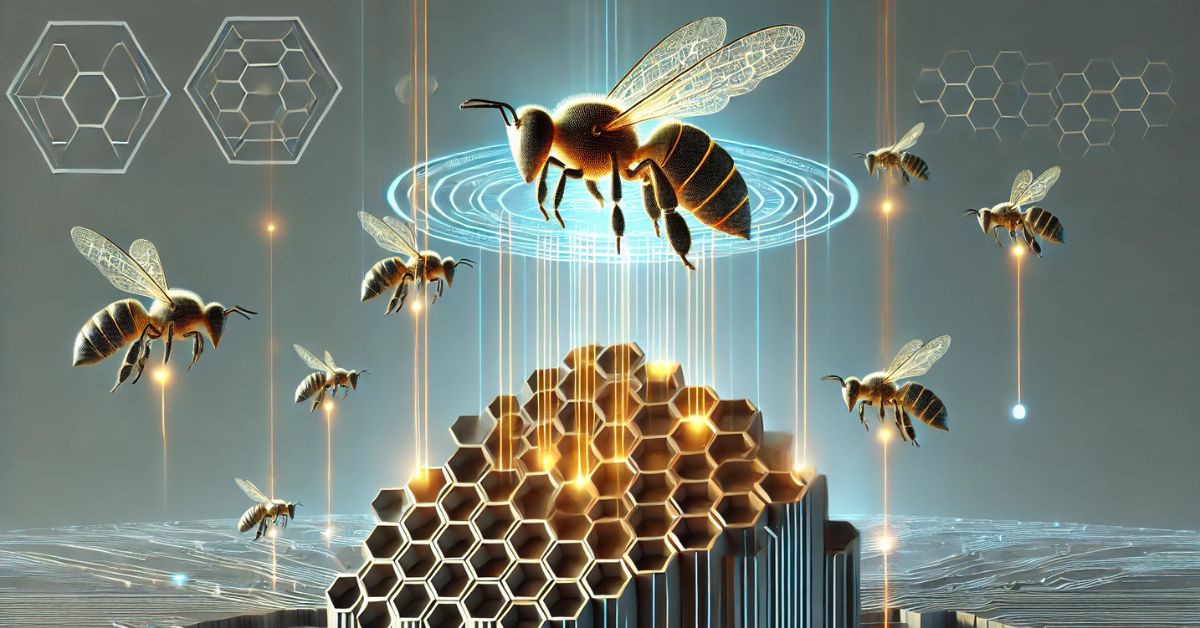Nature has long been a source of inspiration for human innovation. One of the most fascinating examples of natural intelligence comes from honeybee colonies. The way bees make collective decisions offers valuable insights into distributed problem-solving—insights that have now found their way into cutting-edge artificial intelligence systems.
Enter cognitive hive AI (CHAI), a revolutionary approach to AI that draws inspiration from the decision-making processes of honeybee swarms. CHAI takes the decentralized intelligence of bee colonies and supercharges it with advanced computing capabilities, creating an AI architecture that’s more flexible, transparent, and powerful than traditional monolithic systems.
Understanding beehive logic
To appreciate how CHAI works, we first need to understand the remarkable decision-making process of honeybees. When a bee colony outgrows its hive, it faces a critical challenge: finding a suitable new home. This process is a masterclass in collective intelligence.
Scout bees, typically around 5% of the swarm, set out to explore potential nest sites. Upon returning, they perform the famous “waggle dance” to communicate their findings. This dance is a sophisticated form of symbolic communication, where the angle of the dance indicates the direction of the site, the duration signifies the distance, and the vigor reflects the scout’s assessment of the site’s quality.
Other bees follow these dances and visit the advertised sites. If they agree with the assessment, they may become advocates themselves, returning to perform their own dances. This creates a competitive process where multiple sites are often in contention, with different groups of scouts promoting various options.
Instead of aiming for unanimous agreement, the swarm uses a quorum-sensing mechanism. When about 15 scouts have gathered at a particular site, a decision is triggered. This allows for efficient decision-making without getting bogged down in achieving total consensus.
Parallels between beehive logic and CHAI
CHAI mirrors several aspects of beehive decision-making:
- Distributed intelligence: Like a bee swarm, CHAI leverages multiple independent agents to gather and process information.
- Parallel processing: Just as bees evaluate multiple sites simultaneously, CHAI can process various aspects of a problem concurrently.
- Weighted decision making: The intensity of the waggle dance serves as a weighting mechanism, similar to how CHAI’s central coordinator weighs inputs from different modules.
- Adaptability: Bee swarms can adjust to new information as it becomes available, mirroring CHAI’s ability to dynamically update its decision-making process.
- Efficient consensus-building: The quorum-sensing mechanism allows for quick decisions without requiring complete unanimity, similar to how CHAI can make efficient decisions without needing all modules to agree.
Where CHAI surpasses nature
While CHAI draws inspiration from beehive logic, it significantly advances beyond this natural model:
- Diversity of inputs: While bees are limited to evaluating nest sites or food sources, CHAI modules can process a vast array of data types and problem domains. From text and images to complex numerical data, CHAI can handle it all.
- Sophisticated central coordination: CHAI’s “queen bee” is a neural network that far surpasses the simple quorum mechanism of real bees. This allows for more nuanced integration of diverse inputs and complex decision-making.
- Rapid adaptability: CHAI can dynamically adjust its module composition and weighting in real-time, far outpacing the evolutionary timescales of natural systems. This means CHAI can adapt to new situations or data almost instantaneously.
- Scalability: While bee swarms are limited by biological constraints, CHAI can incorporate an ever-growing number of specialized modules. This allows it to tackle increasingly complex problems as it scales.
- Multi-objective optimization: Unlike bees focused on a single goal (finding a new home or finding food), CHAI can balance multiple, sometimes conflicting objectives in its decision-making process. This makes it ideal for complex real-world problems with multiple stakeholders or competing priorities.
CHAI in action: real-world applications
The power of CHAI becomes evident when we look at its potential applications across industries:
- In business, CHAI can revolutionize complex problem-solving. Imagine a supply chain optimization system that considers not just efficiency and cost, but also environmental impact, worker satisfaction, and geopolitical risks—all in real-time.
- For scientific research, CHAI could accelerate discovery by analyzing vast datasets, generating hypotheses, and even designing experiments. Its ability to consider multiple perspectives simultaneously could lead to breakthroughs that might be missed by more linear approaches.
- In healthcare, CHAI could transform diagnostics and treatment planning. By integrating patient data, medical literature, genetic information, and even social determinants of health, it could provide more comprehensive and personalized care recommendations.
- Financial institutions could leverage CHAI for more sophisticated risk assessment and modeling. Its ability to process diverse data types and adapt quickly to changing conditions could lead to more stable and resilient financial systems.
The future of CHAI: pushing the boundaries
As research and development in CHAI continue, we can expect even more exciting advancements. One promising area is AI ethics and safety. CHAI’s modular nature and transparent decision-making process could make it easier to implement robust ethical guidelines and safety checks.
Looking ahead, CHAI could play a crucial role in addressing global challenges. From climate change modeling to pandemic response planning, its ability to handle complex, multi-faceted problems makes it well-suited for tackling some of humanity’s most pressing issues.
CHAI represents a significant leap forward in AI architecture. By building upon the wisdom of nature—specifically, the collective intelligence of honeybees—and then surpassing it with advanced computing capabilities, CHAI offers a more flexible, transparent, and powerful approach to artificial intelligence. As we continue to explore and refine this technology, we’re not just creating smarter machines; we’re developing AI systems that can work more harmoniously with human intelligence, leading to solutions that are greater than the sum of their parts.
The buzz about CHAI is more than just hype—it’s the sound of a revolution in AI, inspired by the humble honeybee but reaching far beyond the constraints of nature. As we stand on the cusp of this new era in AI, one thing is clear: the future of intelligent systems is looking decidedly more hive-minded.
